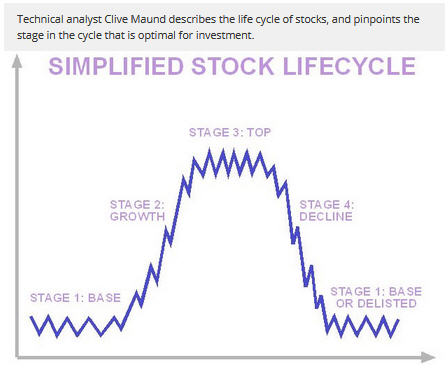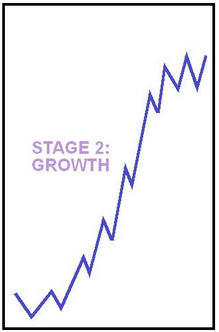
Stocks are like living things. They are born, grow, mature, age and decline and then die, or are reborn, which reflects the fact that the companies on which they are based do likewise.
This should not be so surprising since companies are comprised of people. Whole industries come and go as a result of the evolution of technology and changing fashions. A simple example of this is provided by the music industry, where first you had vinyl, then cassettes, then CDs and now the industry is moving to downloads, with vinyl making a niche comeback. If you as a company had insisted on continuing to produce music on vinyl or on cassettes, you would have gone the way of the Dodo bird.
The only instances where companies and stocks do not go through the entire cycle to the death phase are unique cases where the company comes out with a very distinct product that has staying power, like Coca Cola and McDonalds, and even these can't go on forever. Even Apple's grandiose donut HQ near San Francisco will probably end up a tumbleweed-strewn ghost town, but don’t tell management that—they have to find something to do with their current massive windfall profits.
The normal stock life cycle plays out over a matter of some years although it can vary wildly with individual stocks depending on the industry the company is in. A chart showing a simplified stock life cycle is shown above.
A company is born into Stage 1, the basing phase, which can be likened to a young tree in a forest, which has to contend with hazards like rabbits and falling branches and needs enough light to make it through the canopy above. At this stage many young companies fall by the wayside, due to insufficient funds and/or being crowded out by the competition or other reasons. During this stage the company must "get its act together," and if it succeeds in establishing itself in the marketplace and securing a revenue stream from sales, it makes it to Stage 2, the growth phase, the equivalent of the young tree making it to the canopy above and finding its place in the sun, and growing and developing.
This is the stage at which a company's products may become very popular and sales may expand a lot generating big profits. Eventually, however, growth reaches its limit: "No tree grows to the sky." With Parkinson's Laws dictating rising bureaucracy and costs with management typically feasting on the profits, growth slows as the company matures and ends up treading water until it succumbs to the growing inroads made by leaner and meaner competition, or to a decline in popularity of its products, or both. This is Stage 3, the top phase.
Once the company loses its edge and sales and profits decline, it enters Stage 4, the declining phase. This often ends in a crisis where either the company goes broke or it reinvents itself, in another Stage 1 basing phase from which it may succeed in emerging into a new Stage 2 growth phase.
There are innumerable examples of this stock life cycle playing out in the markets all the time. Sometimes you have entire sectors caught up in it, like precious metals stocks, which enjoyed a Stage 2 boom in the 2000s before a Stage 3 top out in 2011 that led to a vicious Stage 4 bear market, which wiped out a lot of believers. A dramatic example was the tech bubble leading into 2000. Cannabis stocks are believed to be completing a heavy correction within an ongoing Stage 2 bull market. We have a range of more obvious Stage 2 stocks on the site, like Scientific Metals Corp. (STM:TSX.V), Select Sands Corp. (SNS:TSX.V) and UGE International Ltd. (UGE:TSX.V; UGEIF:OTC).
With an awareness of this stock life cycle, our goal is to find those stocks that are in Stage 2 uptrends and ride them for all they are worth. Sometimes we can finesse it, as we have done successfully with Scientific Metals, and keep dodging the corrections to maximize profits.
The Stage 3 top area is a tricky place to make profits, although aggressive traders may successfully play the swings, if they are big enough. Stage 4 is a no-go area, unless you are out to make money on the short side. Stage 1, the basing phase, is associated with "Smart Money," which gets in cheap and ahead of the crowd in Stage 2, although even here you have to be careful—the basing phase can last years and you can end up feeling like a lemon if you buy too early and get stuck with something that does nothing for a long time, as happened to us with some of our recent picks that we bought too early. A stock may be fundamentally very cheap, at say 20 cents, in the Stage 1 basing phase, but because it is very cheap it can easily drop to 10 cents, in which case you are nursing a 50% loss, regardless of whether it goes on to break out into Stage 2 and advance to $2.00 or whatever.
Here we should note that some stocks never make it from Stage 1 to Stage 2—they wither and die like a young tree in the forest starved of sunlight. It is tempting to try to anticipate the breakout into Stage 2, however, because a breakout from a low level can quickly lead to 100% or 200% gains in short order just on the breakout move. We achieved this with UGE International, which we bought last December, aided by clues provided by the volume pattern. The correct interpretation of the volume pattern is the most effective way to call these breakouts ahead of time.
This is where we should focus our attention. . .

A key point to make is that the simplified life cycle chart shown above makes it look very easy to pinpoint where stocks are in their life cycle. In practice it is not so easy—don't forget there are armies of brokers, investors and computer bots that are trying to do just that, which is why most stock charts are not so clear. Anyone who has experience of the markets knows that seemingly insane gyrations are not an infrequent occurrence, so we cannot expect to be right all the time in our interpretations, and only a fool would expect that. What matters is to be right most of the time, and to limit loss when wrong.
To recap, our goal is to isolate those stocks that are in Stage 2 uptrends and ride them for all they are worth. We also try to anticipate breakouts from Stage 1 basing patterns into Stage 2 uptrends, because of the increased leverage that affords. While this can be tricky, the success rate can be improved considerably by the correct interpretation of the volume pattern. As pragmatic traders we couldn't give two hoots what sector they are in, because we don't fall in love with sectors like precious metals or tech or whatever. If you want to fall in love, do it with a man or woman, or a pet dog, or even a tree, not some company's stock.
The stock market is a game, and the best way to win it is to find stocks that are definitely in Stage 2 uptrends, and then ride them until they top out in Stage 3, then switch to others. It is an entertaining quest to find such stocks, and I will appreciate the reduction in my workload that will result in you finding some of these stocks and then alerting me to them. Write to me at clivemaund@gmail.com with any you think you have spotted and I will give you my opinion.
Clive Maund has been president of www.clivemaund.com, a successful resource sector website, since its inception in 2003. He has 30 years' experience in technical analysis and has worked for banks, commodity brokers and stockbrokers in the City of London. He holds a Diploma in Technical Analysis from the UK Society of Technical Analysts.
Disclosure:
1) Clive Maund: I, or members of my immediate household or family, own shares of the following companies mentioned in this article: None. I personally am, or members of my immediate household or family are, paid by the following companies mentioned in this article: None. My company has a financial relationship with the following companies mentioned in this article: None. I determined which companies would be included in this article based on my research and understanding of the sector.
2) The following companies mentioned in this article are sponsors of Streetwise Reports: None. Streetwise Reports does not accept stock in exchange for its services. Click here for important disclosures about sponsor fees. The information provided above is for informational purposes only and is not a recommendation to buy or sell any security.
3) Statements and opinions expressed are the opinions of the author and not of Streetwise Reports or its officers. The author is wholly responsible for the validity of the statements. The author was not paid by Streetwise Reports for this article. Streetwise Reports was not paid by the author to publish or syndicate this article.
4) This article does not constitute investment advice. Each reader is encouraged to consult with his or her individual financial professional and any action a reader takes as a result of information presented here is his or her own responsibility. By opening this page, each reader accepts and agrees to Streetwise Reports' terms of use and full legal disclaimer. This article is not a solicitation for investment. Streetwise Reports does not render general or specific investment advice and the information on Streetwise Reports should not be considered a recommendation to buy or sell any security. Streetwise Reports does not endorse or recommend the business, products, services or securities of any company mentioned on Streetwise Reports.
5) From time to time, Streetwise Reports LLC and its directors, officers, employees or members of their families, as well as persons interviewed for articles and interviews on the site, may have a long or short position in securities mentioned. Directors, officers, employees or members of their immediate families are prohibited from making purchases and/or sales of those securities in the open market or otherwise from the time of the interview or the decision to write an article, until one week after the publication of the interview or article. As of the date of this article, officers and/or employees of Streetwise Reports LLC (including members of their household) own shares of Scientific Metals, Select Sands and UGE International, companies mentioned in this article.